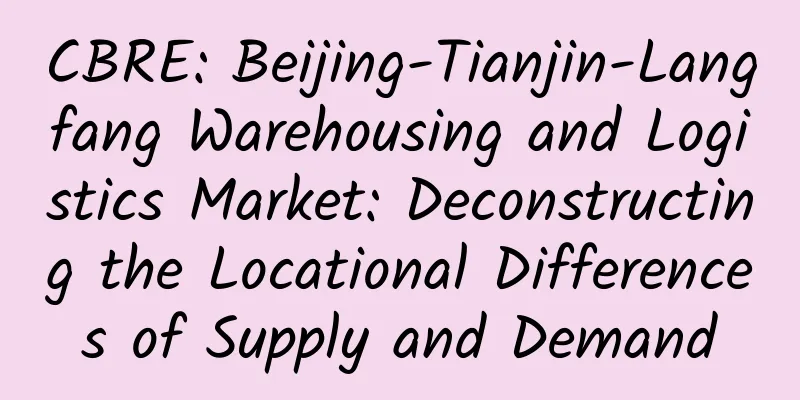CBRE: Beijing-Tianjin-Langfang Warehousing and Logistics Market: Deconstructing the Locational Differences of Supply and Demand

|
Since 2020, the stock of high-standard warehouses in Beijing, Tianjin and Langfang has entered a period of accelerated growth. In 2022, the new supply will reach 2.6 million square meters, corresponding to a 28% growth rate in stock expansion that year; the average annual new supply from 2023 to 2025 is expected to remain at 2.1 million square meters. In the second quarter of 2023, the vacancy rates in Beijing, Tianjin and Langfang reached 15.0%, 30.2% and 50.2% respectively. The huge new volume has caused market concerns: Will the overall market in Beijing, Tianjin and Langfang be trapped in a long-term imbalance between supply and demand and a downward trend in rents? The analysis and answer to this question cannot be generalized. CBRE recently released a special report "Beijing-Tianjin-Langfang Warehousing and Logistics Market: Deconstructing the Location Differences of Supply and Demand", which deconstructs the differences in supply and demand in different sub-markets of Beijing-Tianjin-Langfang from multiple perspectives, and predicts their future trends, so as to provide strategic suggestions for user companies and investors in the logistics layout of Beijing-Tianjin-Langfang. Data source: CBRE Research, August 2023 01. Location differences on the supply side Supply from the perspective of scale effect With key factors such as location and transportation facilities in place, the orderly and stable increase in supply provides sufficient space support for tenants to choose a location, attracts the continuous introduction of tenant resources, and promotes the formation and continuous strengthening of industrial agglomeration, and promotes the simultaneous improvement of the scale effect of industry (demand) and its space carrier (supply). However, in reality, the development rhythm of demand and supply is not consistent. Looking at the main logistics sub-markets in the Beijing-Tianjin-Hebei region, through a comprehensive analysis of indicators such as development time, government planning, and existing leased area, we believe that the cluster composed of Beijing Majuqiao and its neighboring Economic Development Zone and Tongzhou, the cluster composed of Shunyi Airport and its expansion area (Shunyi others), Daxing Jingnan, Tianjin Wuqing, Binhai New Area, Beichen, and Xiqing have a history of high-standard warehouse development for more than ten years. They are all logistics development areas that are key planned by the government, and the total leased area has formed a scale. Therefore, they are the most mature cornerstone markets in the Beijing-Tianjin-Hebei region with the strongest scale and agglomeration effects. More importantly, understanding the historical causes of industrial agglomeration and scale effects will provide a more comprehensive perspective for examining and judging the future growth trends of emerging areas in this round of accelerated development of the Beijing-Tianjin-Langfang logistics market. Taking into account multiple factors such as government planning, location, and surrounding major infrastructure, CBRE believes that from a medium- to long-term perspective, the Daxing Airport surrounding cluster composed of Daxing Airport and Langfang Airport Economic Zone, Pinggu Mafang and the northern three counties are expected to become emerging logistics agglomeration areas in the Beijing-Tianjin-Langfang region in the next three years. Data source: CBRE Research, August 2023 Regional differences in destocking pressure From the perspective of scale effect, we divide each sub-market into statistics of the area to be sold to identify the regional differences in sales pressure: The six sub-markets with the least area to be sold are all located in Beijing. Majuqiao and Daxing Jingnan are self-contained, while Beijing Economic Development Zone, Tongzhou and Majuqiao work together. These sub-markets have the least pressure to sell. Other future supplies in Beijing Shunyi can effectively supplement Shunyi Airport and strengthen the overall scale advantage of the two districts. Xiqing has the advantages of strong scale effect and small area to be sold, and is the sub-market with the least pressure on Tianjin. Although the area to be sold in Tianjin Binhai New Area and Wuqing is large, the proportion of the total stock is relatively balanced, and the difficulty of selling is relatively controllable; Other sub-markets face significant pressure to sell out in the short term. Among them, Daxing Airport, Langfang Airport Economic Zone and Tianjin Airport are relatively less pressured to sell out due to the airport effect. Data source: CBRE Research, August 2023 02. Location differences on the demand side Demand engine and energy Third-party logistics, e-commerce, wholesale and retail, manufacturing, and cold chain are the main source industries for the demand for high-standard warehouses in Beijing, Tianjin and Langfang. Further summarizing, the demand can be divided into two major driving engines: retail and manufacturing. Third-party logistics spans retail and manufacturing, while cold chain is a demand industry with special attributes. Different sub-markets have different attractiveness to different types of demand due to their own geographical location, transportation facilities, surrounding industrial development and other resource characteristics. Through the summary and analysis of new lease transactions from 2020 to date, we can reflect the demand energy of various industries in each sub-market. Combined with the evolution of the future development and layout of various industries, we can also predict the development potential of demand in each sub-market. E-commerce development and traditional retail chain E-commerce and wholesale and retail warehousing both require large areas, high turnover and timeliness requirements, and need to comprehensively consider distance from key consumer markets, transportation convenience, property quality and selectivity, rental levels, etc. The sub-markets outside Beijing and around Beijing are the first choice due to their cost-effectiveness . In addition, Tianjin's local consumer market also supports the demand for its suburban sub-markets. Data source: CBRE Research, August 2023 Manufacturing supply chain upgrade In terms of location selection, manufacturing companies require to be as close as possible to upstream and downstream companies to enhance the coordination of the supply chain. Therefore, high-standard warehouses near manufacturing bases and transportation facilities such as airports, railways, highways, and ports are more popular. Data source: CBRE Research, August 2023 Third-party logistics layout Since the intrinsic driving force and location preference of third-party logistics demand are consistent with the types of customers they serve, we divide third-party logistics as a whole into two categories: retail-related and manufacturing-related, and analyze them in combination with the two major industries of retail and manufacturing respectively. Popularization of cold chain Cold chain tenants have higher requirements for transportation convenience, property power distribution, environmental protection, safety and customization than other types of tenants. As the choice of core areas in Beijing is extremely limited, the peripheral and sub-markets around Beijing are gradually becoming the first choice for cold chain tenants due to their moderate distance and greater choice of high-quality properties. As an important consumer market in the north, a port and distribution center for fresh food and pharmaceutical imports, Tianjin is of great significance to the demand for cold chain city distribution warehouses, port warehouses and regional distribution. Location demand potential factor: distance from Beijing The future demand development potential of different sub-markets is not only related to the development of their demand industries, but also determined by their own conditions. Through analysis, it is found that the distance from Beijing and transportation facilities are the two core factors affecting the demand energy of each sub-market in the Beijing-Tianjin-Langfang area. The driving distance from Beijing’s main urban area (fifth ring road) is an important criterion for identifying the demand potential of sub-markets, which can be divided into three circles:
By studying the degree of deviation of each submarket from the trend line, we found that although some Langfang submarkets are closer to the Fifth Ring Road than Beijing's suburban submarkets, their rents are lower. The main reason is that when entering Beijing from Langfang, you need to pass through checkpoints, which takes longer time at the same distance. This is particularly evident in some special circumstances, such as epidemics and major events held in Beijing. Many tenants are willing to bear the rental premium of submarkets within Beijing to avoid this uncertainty. CBRE infers that the checkpoints into Beijing are the key variables that restrict the demand of submarkets around Beijing and are most likely to achieve breakthroughs in the next three years . Among them, Langfang Airport Economic Zone and the three northern counties are key areas under the Beijing-Tianjin-Hebei coordinated strategy. If they can be integrated with Beijing Daxing and Tongzhou, it will significantly increase the demand for locations. Data source: CBRE Research, August 2023 Location demand potential factor: transportation facilities Airport Due to the characteristics of air cargo itself in terms of transportation timeliness and quality requirements, the airport plays the most significant role in importing cargo flows to nearby high-standard warehouses, especially in terms of the ability to bear high rents. Shunyi Airport and Daxing Airport are the two sub-markets with the highest rents in Beijing, while Tianjin Airport and Langfang Airport Economic Zone are more than 10% higher than the average rent in the city. In the future, as the scale of air cargo transportation at various airports grows, a large amount of new demand will be introduced to Daxing Airport and Langfang Airport Economic Zone . Ports and railways The Binhai New Area is the only sub-market in the Beijing-Tianjin-Langfang area that is close to a seaport. Therefore, it carries a large number of special demands such as bonded areas and export processing. The rent is 3% higher than the Tianjin average. At present, the domestic high-standard warehouse goods are less dependent on rail transportation, and the contribution of nearby railway stations to demand is limited, but the advantages of railways in long-distance transportation of specific goods are expected to emerge in the future, which will to a certain extent drive the development of a few sub-markets in the Beijing-Tianjin-Langfang area with freight railway station resources. highway As freight transportation relies on highways, the surrounding expressway network determines the differences in freight flow and warehousing demand in each submarket. Taking into account various indicators such as the number of adjacent expressways, entrance distance, transportation flow, and the level of connected cities in each submarket, we found that Tianjin Wuqing, Xiqing, Binhai New Area, Jinghai, Langfang Economic Development Zone, Linkong Economic Zone, Guangyang Economic Development Zone, Beisan County, and Gu'an have comprehensive advantages in expressway networks and have a head start in attracting cross-city and regional distribution needs. 03. Investment strategy recommendations and supply and demand structure rating Based on the supply and demand indicators analyzed above, CBRE divides the 28 sub-markets of Beijing, Tianjin and Langfang into four tiers. The tier rating mainly reflects the supply and demand balance of each sub-market from now to the next three years, and is also closely related to the future rental trend, so it is an important reference for investment site selection decisions. Data source: CBRE Research, August 2023 Overall, the current investment strategy opportunities in Beijing-Tianjin-Langfang warehousing and logistics are mainly development-oriented and value-added, supplemented by core-oriented. Combining the results of the supply and demand structure analysis, CBRE recommends the following sub-markets for each investment strategy type: Opportunistic Pinggu Mafang is the only sub-market in Beijing that currently sells logistics land with a 50-year use period. It has the largest room for expansion and the highest degree of marketization in land transactions. Although the land price stands out among the sub-markets in Beijing, Tianjin and Langfang, the rental return rate is at a relatively high level, which is still very attractive to long-term investors. Langfang Airport Economic Zone and the northern three counties are the sub-markets in the Beijing-Tianjin-Langfang area with the highest rental return rate for first-hand logistics land with a 50-year use period. They are also the sub-markets with the greatest chance of achieving integration with Beijing in the future, and have great potential for future appreciation. Value-added Shunyi Airport and its expansion area are the first choice for value-added investment. Compared with other mature areas in Beijing, the local policy environment is more open and supportive of stock renewal and transformation. In addition, its future supply and demand structure balance, rental stability and growth are also strong guarantees for value-added investment returns. You can pay close attention to value-added investment opportunities in sub-markets such as Majuqiao, Beijing Economic and Technological Development Zone, Daxing Jingnan, and Tongzhou that meet government regulatory requirements. Core Several core assets in the Beijing-Tianjin-Langfang region have been listed through C-REIT. Among them, the recent stable return performance of properties located in sub-markets such as Beijing Shunyi Airport and Tongzhou reflects the value of these sub-markets to core investment strategies. Beijing's first- and second-tier sub-markets are the main targets of core investment, but as sellers are extremely reluctant to sell, investable properties are scarce. You can pay attention to asset packages that include such properties and consider their investability based on the overall quality and pricing level of the asset packages. Source: CBRE |
<<: How big is the e-commerce market potential in this Middle Eastern country?
>>: Non-aviation revenue: How do airports promote passenger spending through various means?
Recommend
The efficacy and function of hard bluegrass
For the Chinese medicinal material such as Poa sc...
What are the medicinal values of Metasequoia
Metasequoia trees are basically distributed in th...
When is the best time to take Chinese medicine?
There are certain requirements for Chinese medici...
Is the ocean warming making the octopus' eyesight worse? | Nature Trumpet
Welcome to the 56th issue of the Nature Trumpet c...
What are the effects of winter, spring and summer grass
Among traditional Chinese medicines, there is one...
How to eat parsnip root
Saposhnikovia root is a relatively common plant a...
One medicine can save your liver
Schisandra chinensis is a traditional Chinese med...
The efficacy and function of Huixincao
The Chinese herbal medicine Huixincao is a relati...
The "disappeared him" scene at the beach, the killer behind it is actually...
Audit expert: Yi Jingkun Zhihu famous geography a...
Dandelion root benefits and contraindications
Dandelion is a very common natural woody plant, a...
What are the traditional Chinese medicines for strengthening the spleen and stomach of children?
Being picky about food is a common problem among ...
In the new semester, Beijing issued "new rules for physical education classes". How should upper limb training be performed?
Recently, the “Eight Rules for Physical Education...
"Sun God Clothes" are here! Chinese universities develop 24-hour constant temperature smart clothing, it's so cool
This winter is too cold. On December 16, the Cent...
The efficacy and function of parasitic yellow
There are many types of Chinese medicine. When we...

![[Smart Farmers] How to check if fruits are "injured"? Fruit "Doctor" is now online!](/upload/images/67f0a03e2c983.webp)





![[Body Wandering] How come a stone grows in a healthy kidney?](/upload/images/67effb0f24abb.webp)

